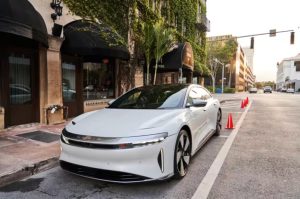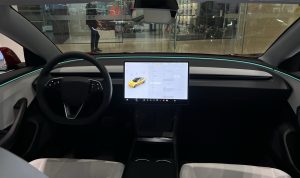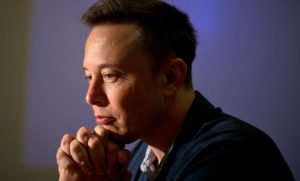Tesla’s new Model 3 has been officially unveiled with significant changes to its exterior and interior design.
7 min read
This marks a redesign after 7 years.
Six years ago, Tesla held a grand launch event for the Model 3, with the presence of Tesla’s CEO and Chief Design Officer.
During that launch event, Elon Musk candidly stated, “Model 3 is the company’s top priority.”
Fast forward six years, and the next generation of Tesla Model 3 has quietly appeared on Tesla’s official website, without any launch event, media coverage, or test drives. Everything has been kept under wraps.
Now, let’s follow the reporting from the Dong Che Hui to take a look at the all-new look of this vehicle that everyone is so familiar with.

On the Tesla official website, we can see the prices for the new Model 3:
- Model 3 Refreshed Version: Starting at 259,900 RMB.
- Model 3 Long Range Refreshed Version: Starting at 295,900 RMB.
It’s worth noting that Tesla has temporarily not provided the option to purchase the performance version, but the long-range version has made its official return. The Model 3 Refreshed Version offers a CLTC range of 567 kilometers with a 0-100 km/h acceleration in 6.1 seconds. The returning long-range version now boasts a range of over 682 kilometers, reaching 713 kilometers, and it accelerates from 0 to 100 km/h in 4.4 seconds.
New Exterior and Interior Design
If the keywords for the old Model 3 were “rounded” and “smooth,” the new model adds a touch of sharpness to that roundness.
Changes to the front of the Model 3 have long been known. As early as April this year, the new front of the Model 3 was leaked. The new Model 3 features a front bumper with simpler lines, and the matrix-style headlights have a more aggressive look with golden accents on the inside.

The fog lights that were originally located at the bottom have disappeared, replaced by a simple curved line that outlines the lower air intake. This sharp design reduces aerodynamic drag, and according to Tesla’s official statement, the new model has a drag coefficient of only 0.22.
New color options are also a highlight of the updated Model 3. Tesla offers two new color choices for this model, including the Flame Red and Starry Gray, which are available for an additional cost of 12,000 RMB.
Real-world display of the two new color options
Moving to the side, the only difference you’ll notice is in the wheel designs. The updated Model 3 offers a choice between two wheel styles: the standard 18-inch Photon wheels and the new 19-inch Nebula wheels, which are available for an additional cost of 6,000 RMB.

The 19-inch Nebula wheels.
The rear view is also an excellent angle to identify the new car. The slim, curving red line follows the changes in the headlights, and the lower part features a more pronounced diffuser. Interestingly, Tesla has also changed the badge design at the rear, replacing the original logo with the letter-style “TESLA.”
Apart from the exterior updates, the most significant changes are found in the interior.
Upon entering the vehicle, at first glance, it still has that familiar feel. However, upon closer inspection, everything appears to be quite different.

The new dashboard integrates the previously separate three components into one unit, undoubtedly a clever cost-cutting measure. The original wooden trim has been replaced by a new gray accent strip. Tesla has also added multi-color ambient lighting to the new wraparound cockpit, which can be considered an “epic-level upgrade” for what was essentially a blank canvas.
Interior Materials
The door panel design has also undergone changes, and the trim on the dashboard no longer extends to the sides. In terms of materials, Tesla has replaced the Alcantara on the door panels with new fabric. Furthermore, the new Model 3 has replaced the physical door opening buttons with the touch-sensitive buttons found on the current Model S/X.
However, regardless of the design changes, the real game-changer is the Model 3’s interaction.

Now, you don’t have to use a gear lever to control the forward and reverse movements of the Model 3; Tesla has placed it on the center touchscreen within your reach. With a simple swipe of your finger, swipe up for forward and down for reverse. What if the screen goes black or freezes? Don’t worry; there are touch buttons below the screen.
Tesla believes that shifting gears is not a frequent operation. Think about it – do you change gears while the vehicle is in motion? Clearly not. You only use it when starting or making a U-turn on narrow roads. It can be foreseen that Tesla will soon enable the Model 3 to shift automatically by recognizing the surrounding environment.
What Tesla wants to remove is not the gear lever but the act of shifting gears itself.
Now, shift your attention to the other side; Tesla has also removed the turn signal stalk. Buttons for functions like turn signals and horn have been integrated into the steering wheel as pressure-sensitive buttons. Additionally, the steering wheel’s style has changed, with the new Model 3 adopting the same steering wheel style previously seen in the exposed Cybertruck.
Regarding this design, members of the media have invited several guests with different driving experience and perspectives to experience it. The result is that most of them got used to the pressure-sensitive buttons within 25 minutes. Of course, whether this design is user-friendly will need time to validate.
It’s not just what you can see in front of you; the seats under your rear end have also changed. The new front seats of the Model 3 are wrapped in perforated leather, and fans at the bottom of the seats cool them by drawing in air. In the rear, Tesla has added an 8-inch center screen, which supports entertainment and in-car functions.

Now, you don’t have to use a gear lever to control the forward and reverse movements of the Model 3; Tesla has placed it on the center touchscreen within your reach. With a simple swipe of your finger, swipe up for forward and down for reverse. What if the screen goes black or freezes? Don’t worry; there are touch buttons below the screen.
Tesla believes that shifting gears is not a frequent operation. Think about it – do you change gears while the vehicle is in motion? Clearly not. You only use it when starting or making a U-turn on narrow roads. It can be foreseen that Tesla will soon enable the Model 3 to shift automatically by recognizing the surrounding environment.
What Tesla wants to remove is not the gear lever but the act of shifting gears itself.
Now, shift your attention to the other side; Tesla has also removed the turn signal stalk. Buttons for functions like turn signals and horn have been integrated into the steering wheel as pressure-sensitive buttons. Additionally, the steering wheel’s style has changed, with the new Model 3 adopting the same steering wheel style previously seen in the exposed Cybertruck.
Regarding this design, members of the media have invited several guests with different driving experience and perspectives to experience it. The result is that most of them got used to the pressure-sensitive buttons within 25 minutes. Of course, whether this design is user-friendly will need time to validate.
It’s not just what you can see in front of you; the seats under your rear end have also changed. The new front seats of the Model 3 are wrapped in perforated leather, and fans at the bottom of the seats cool them by drawing in air. In the rear, Tesla has added an 8-inch center screen, which supports entertainment and in-car functions.

Like the new Model S/X released earlier this year, Tesla has removed all sensors from the Model 3 and relies solely on cameras to implement the Tesla Vision driver-assistance system. Do you remember the additional radar in the front of the new Model 3? It’s replacing the forward-facing millimeter-wave radar.
In terms of smart driving, unlike the HW 3.5 hardware that was widely rumored, the new Model 3 is following in the footsteps of the Model Y and comes with Tesla’s latest HW 4.0 hardware for autonomous driving. The incorporation of these new components implies increased costs, which may be related to the price increase of the new Model 3.
Despite the technological trends, in reality, the removal of the millimeter-wave radar, the integration of dashboard components, the removal of the physical gear lever, and the use of new interior materials all point to one thing: cost reduction.
As a well-known “cost reduction master” in the industry, Tesla has never missed any opportunity to reduce costs.
Former Tesla CFO Zach Kirkhorn once revealed to the public that since the official launch of the Model 3 in 2017, Tesla has been refining its processes to reduce manufacturing costs. By the beginning of 2023, the Model 3’s electric drive unit had reduced weight by 20%, the central touchscreen had successfully reduced weight by 12%, and its energy consumption had decreased by 33%, resulting in an overall cost reduction of over 30%.
However, surprisingly, the price of the new Model 3 has not come down to the level we expected, which was under 200,000 RMB. The starting price of 259,900 RMB is nearly 20,000 RMB higher than the starting price of the old Model 3.
The biggest significance of the new Model 3 is that Tesla is extending its completely new car interaction design to cover more models. In the past, if you wanted a completely new interaction, you had to buy a Model S/X. But now things are different. Tesla has brought its new interaction to this 259,900 RMB Model 3. If you can’t afford the Model S/X, don’t worry. In the Model 3, you can still experience unlimited possibilities. Automatic turn signals, automatic gear shifting, and even autonomous driving, Tesla’s vision has taken a step further in this Model 3.
In the electric vehicle industry, we’re looking forward to a change. The release of the new Model 3 is just the beginning, and with Tesla’s cost reduction measures and continuous optimization of production methods, the Refresh version is expected to appear on the market at a more affordable price.



